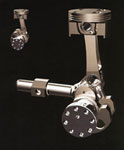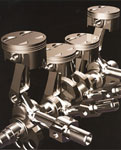

reprinted from Automotive Engineering, January 2002
Mayflower's variable engine technology
 |
| Mayflower's e3 engine technology uses a pivoted lever arm between the connecting rod and crankshaft. Benefits are said to include major reductions in fuel consumption and emissions. |
 |
It is called the Mayflower e3 Variable Motion Engine, and it could bring a new dimension to the efficiency of the internal-combustion engine, say its inventors and developers. Mayflower Corp., a British automotive and specialist engineering and manufacturing company, with operations in the UK, Continental Europe, Asia, and North America, claims that initial test results indicate a fuel-consumption improvement of 40%, with a 50% reduction in emissions. Variable compression ratio and engine "capacity on demand" are other elements of the technology.
The central aspect of Mayflower e3 is described as a pivoted lever arm between the connecting rod and crankshaft. This configuration gives an "elliptical" path to the con-rod big end, which causes the piston to slow momentarily immediately after ignition, allowing the flame to spread faster. It also provides a longer intake and expansion stroke and ensures the piston and con-rod are positioned to provide positive torque. The net effect is to not only improve combustion, thereby increasing power and reducing emissions, but also to create an engine that runs more quietly and efficiently.
Mayflower states that the technology is the result of an 11-year development program and is described as the "brainchild" of Joe Ehrlich. Mayflower has a 33% stake in the technology rights. Giving details of the system in London, the company described the lever arm as being pivoted at a single point attached to the engine housing at one side of the crankshaft. This pivot point can be moved vertically and horizontally to vary the lever arm geometry while the engine is running, which has the effect of enabling variations of both the compression ratio and the capacity of the engine as well as giving the Mayflower e3 the ability to adapt intelligently to load demands. The technology is applicable to two-stroke, four-stroke, gasoline, and diesel engines and is able to complement supercharging, turbocharging, variable-valve timing, and direct-injection technology. Mayflower has invested in a multi-million dollar development program and a commercial realization strategy. According to Mayflower Chief Executive John Simpson, introducing the e3 technology into production engines would "not require (a) huge investment" in new plants and facilities. "Production can be introduced without fundamental change to existing manufacturing facilities," he said. "(The) first engines could be in production within five years."